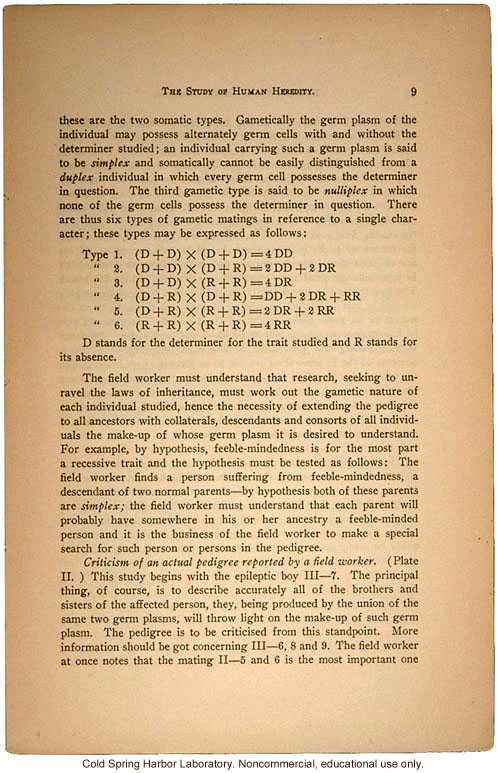The Study of Human Heredity. 9
These are the two somatic types. Gametically the germ plasm of the individual may possess alternately germ cells with and without the determiner studied; an individual carrying such a germ plasm is said to be [italics]simplex[end italics] and somatically cannot be easily distinguished from a [italics]duplex[end italics] individual in which every germ cell possesses the determiner in question. The third gametic type is said to be [italics]nulliplex[end italics] in which none of the germ cells possess the determiner in question. There are thus six types of gametic matings in reference to a single character; these types may be expressed as follows:
Type 1. (D + D) X (D + D) = 4DD
" 2. (D + D) X (D + R) = 2DD + 2DR
" 3. (D + D) X (R + R) = 4 DR
" 4. (D + R) X (D + R) = DD +2DR = RR
" 5. (D + R) X (R + R) = 2DR + 2RR
" 6. (R + R) X (R + R) = 4RR
D stands for the determiner for the trait studied and R stands for its absence.
The field worker must understand that research, seeking to unravel the laws of inheritance, must work out the gametic nature of each individual studied, hence the necessity of extending the pedigree to all ancestors with collaterals, descendants and consorts of all individuals the make-up of whose germ plasm it is desired to understand. For example, by hypothesis, feeble-mindedness is for the most part a recessive trait and the hypothesis must be tested as follows: The field worker finds a person suffering from feeble-mindedness, a descendant of two normal parents - by hypothesis both of these parents are [italics]simplex;[end italics] the field worker must understand that each parent will probably have somewhere in his or her ancestry a feeble-minded person and it is the business of the field worker to make a special search for such person or persons in the pedigree.
[italics]Criticism of an actual pedigree reported by a field worker.[end italics] (Plate II.) This study begins with the epileptic boy III-7. The principal thing, of course, is to describe accurately all of the brothers and sisters of the affected person, they, being produced by the union of the same two germ plasms, will throw light on the make-up of such germ plasm. The pedigree is to be criticized from this standpoint. More information should be got concerning III-6, 8 and 9. The field worker at once notes that the mating II-5 and 6 is the most important one
[end]


